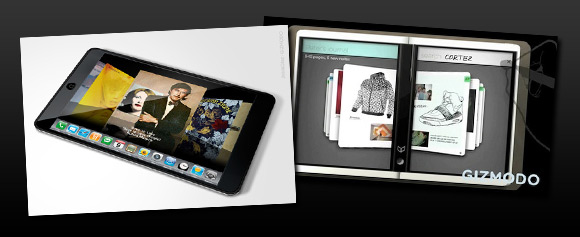It’s an exciting time for those looking forward to the rise of tablet computing devices: Not only are the rumors running rampant about Apple’s potential tablet, we’re also finally seeing what Microsoft is bringing to the table with their Courier project.
Details on Apple’s tablet project are still entirely speculative at this point, but judging from the increasing buildup of rumors we can start to infer a general idea of the device. Apple looks to be building on its iPhone and iPod Touch experience by offering a tablet with a single 10″ screen running the iPhone OS. Microsoft’s Courier, on the other hand, is technically more of a booklet than a tablet – it’s a dual-screen device that offers multitouch and stylus support, and judging from the leaked footage, MS appears to be coming up with entirely new paradigms for working within its tablet environment.

Above left: Mockup of Apple’s tablet. Above right: Microsoft’s dual-screen Courier. Both images courtesy of Gizmodo.
Even if the final products that hit stores aren’t exactly what we see today, it’s worth considering what these early stabs could represent for the future of tablet computing. By taking such different approaches with these products, they also prove the value of the Apple-Microsoft rivalry to the computing market as a whole.
Comparing Microsoft’s Courier to Apple’s tablet
While Apple’s potential tablet seems to be getting most of the hype, I’m personally more intrigued by Microsoft’s Courier project. Microsoft is working from a blank slate with Courier, and though it does remind me quite a bit of a Nintendo DS used in portrait mode, there are definite benefits to that configuration. Its dual screen nature would make it ideal for eBook reading, multitasking without switching windows, and far more portable (and potentially more rugged) than a large single screen.
Courier also seems to benefit from a user-interface created specifically to take advantage of its unique hardware configuration. Microsoft isn’t just trying to force its typical workflow from Windows into the device, instead they’re showing off some of their next-gen UIs we’ve already seen from the likes of Surface and Zune HD. It seems elegant, and most importantly, intuitive, which would be key to helping this device take off with non-techy folk.
Apple’s approach is more evolutionary, rather than a complete departure from their current lineup like Microsoft is doing. Their single-screen tablet would be ideal for reading textbooks, magazines, and newspapers. (And if Gizmodo is to be believed, that seems to be a big part of their plan with this device.) The inclusion of a 3G radio would also make it a lot more versatile when away from Wi-Fi, though I’m not sure if it would be nearly as useful as a 3G-enabled netbook since it lacks a proper keyboard. But of course, this deficiency could be fixed down the line with a wireless keyboard/mouse accessory.
Unsurprisingly, media seems to be the big push with Apple’s tablet, whereas Courier is something I could see helping students and professionals be more productive. With media being the focus of so many devices these days, I’m not certain that there’s much utility with another media streaming screen in the home. I can’t see it being used too much for music, and it seems a bit awkward for prolonged video use. I’m thinking Apple will have to make some sort of stylus available for their tablet for productivity reasons–something which would surely make them the darling of artists and illustrators everywhere.
Why different approaches will ultimately be helpful
The differences between these products provide a pretty clear case why competition is good for the technology sector – especially since it’s the next big showdown between two tech titans. If both Apple and Microsoft decided to trot out products that were too much alike, Apple would have won months before they launched based on marketing alone. Now that the radically different nature of Courier is known, Apple needs to stay on its toes – because Microsoft is thinking different.
There’s definitely a market for both approaches to tablet computing, and they will spur on other companies to join the fun with their own unique variations on the tablet.
Let’s also not forget that another entry in this tablet market has been known for some time – Michael Arrington’s “Crunchpad”. Arrington’s goal was to create a web-centric tablet on the cheap, and I wager that he’ll still manage to create a cheaper device than Apple or Microsoft. While it may not ultimately win out in marketshare, the increasing reality of the Crunchpad probably helped to stoke the fires under Microsoft and Apple to get their own tablet projects running.
Looking forward
Regardless of what devices Apple and Microsoft actually end up launching, there’s no doubt that we’re currently amidst an exciting time for tablet development. Rumors are flying left and right, and they’re actually exciting because this is new territory for everyone involved. While tables may not see mainstream success initially, they will beget a personal computing paradigm shift for many years to come.
About the author:
Devindra Hardawar is a tech/film blogger and podcast host. You can find him writing at the Far Side of Tech and Slashfilm.



























